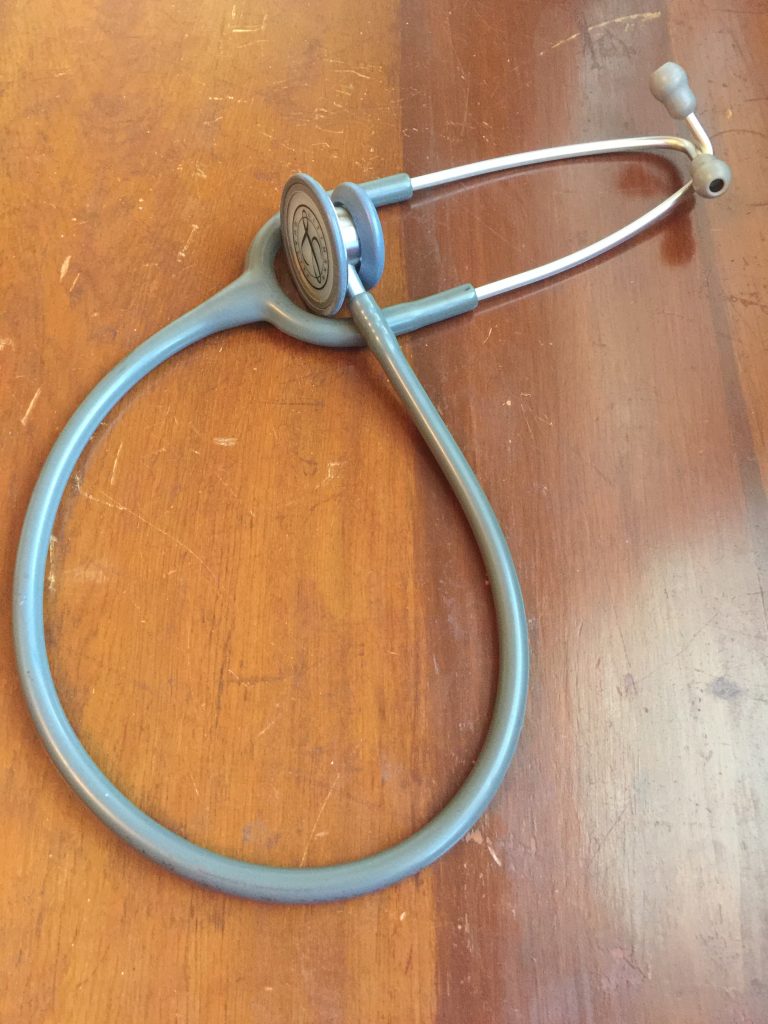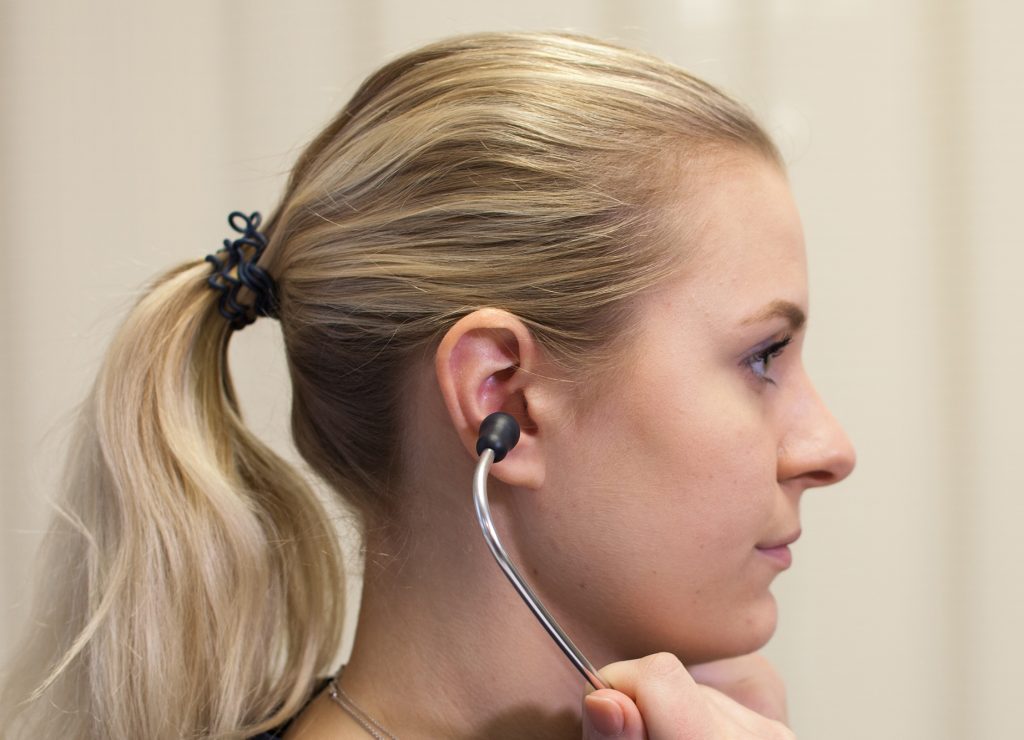Chapter 5 – Physical examination techniques: A nurse’s guide
Auscultation
The assessment technique of auscultation involves listening to the body. Although this is typically performed with a stethoscope, you can sometimes hear sounds from the body using just your ear. For example, you have probably heard your own or another person’s stomach growling; another example is heavy breathing after exercise.
You can perform auscultation on the body to hear several sounds including:
- like lung sounds, bowel sounds, and some heart sounds.
- like some heart sounds, as well as sounds associated with abnormal vascular sounds of the carotid arteries and the aorta.
To perform auscultation, you need a high-quality stethoscope. See Figure 13 for an acoustic stethoscope with a separate diaphragm on one side and a bell on the other side. The diaphragm is used for auscultating high-pitched sounds, while the bell is used for auscultating low-pitched sounds. Another option is an acoustic stethoscope in which the diaphragm and bell are manufactured as one piece: using this type of stethoscope, you can alternate pressure to auscultate for high- or low-pitched sounds, using light pressure to accentuate low-pitched sounds and firmer pressure to accentuate high-pitched sounds. There are also electronic stethoscopes to help amplify sounds for people with hearing loss. Some advanced stethoscopes facilitate better ambient noise reduction, sound amplification, and capability to record sounds (Leng et al., 2015). Unlike electronic stethoscopes, an acoustic stethoscope does not amplify the body’s sounds; it simply reduces interference from extraneous noises around you.

Figure 13: Stethoscope with a separate diaphragm and bell
Use of the stethoscope
Proper use of a stethoscope involves several steps.
- Begin by explaining the procedure and asking permission to touch.
- Next, create a quiet environment. Turn off or mute the sound on cell phones, radios, or televisions. Ask the client to not speak or move while you are listening. Also, many clinical environments have ambient noise that you cannot control, particularly in hospitals, when beds are close together, or in an open concept unit such as an emergency room. You will need to focus your hearing; it may help to close your eyes when listening.
- Third, cleanse the stethoscope. The stethoscope is a potential vector of transmission that can carry pathogenic bacteria (Horiuchi et al., 2018; Tschopp et al., 2016). Clean the entire stethoscope using an alcohol pad on the earpieces and the end piece immediately prior to use. Always clean the stethoscope from cleanest to dirtiest areas, therefore earpieces first and bell/diaphragm last.
- Next, place the earpieces in your ears so that they are pointing toward your nose as per Figure 14. This positioning aligns with the angle of your ear canal and enhances your capacity to hear. You may need to wiggle them into place so that they are comfortable and angling down your ear canal.
- Last, open or close the diaphragm or bell depending on which end piece you want to use. It is important to tap on the diaphragm to ensure sounds are heard if using the diaphragm or not heard if using the bell. See Film Clip 2 on how to open and close the diaphragm and bell.

Figure 14: Positioning in the ears
Film clip 2: Opening and closing the stethoscope
Make note of your findings when performing auscultation. For example, findings may include “clear air entry bilaterally in all lobes” or “high-pitched gurgling bowel sounds present in all four quadrants.”
Clinical Tip
How best to listen
The best practice, supported by evidence, is to conduct assessments on bare skin. Always place the end piece of the stethoscope on bare skin, and never listen over the client’s gown or clothing as this can modify the sounds that you are hearing. In the clinical setting, you will witness many healthcare providers listening over clothing, but this is not the correct way to auscultate sounds. Substantial amounts of hair (e.g., on the chest, back or abdomen) can also create extraneous noise, making it difficult to hear the expected sounds.
For infants, the best time to auscultate is while the infant is sleeping or quiet; if they start crying, encourage the care partner to console the infant by repositioning, breastfeeding/bottle, or soother (if permitted). If you are trying to auscultate the lungs of a young child, you could ask the child to take a big breath and pretend they are blowing bubbles or blowing out candles on a birthday cake.
Voices of Experience
It is important to know the expected normal sounds and the abnormal sounds. You should trust what you are hearing. If you are struggling to identify the sounds you are hearing, try closing your eyes and focusing. If a sound is not normal, act on this and/or ask for a second opinion from your clinical instructor or preceptor. It is always good practice to listen to body sounds in partnership with an expert nurse.
Activity: Check Your Understanding
References
Horiuchi, Y., Wettersten, N., Vasudevan, R., Barnett, O., & Maisel, A. (2018). Stethoscope as a vector for infectious disease. Current Emergency and Hospital Medicine Reports, 6, 120-125. https://doi.org/10.1007/s40138-018-0167-4
Leng, S., Tan, R., Chai, K., Wang, C., Ghista, D., & Zhong, L. (2015). The electronic stethoscope. Biomedical Engineering Online, 14(66), 1-37. http://doi.org/10.1186/s12938-015-0056-y
Tschopp, C., Schneider, A., Longtin, Y., Renzi, G., Schrenzel, J., & Pittet, D. (2016). Predictors of heavy stethoscope contamination following a physical examination. Infection Control & Hospital Epidemiology, 37(6), 673-679. http://doi.org/10.1017/ice.2016.40
High-pitched sounds are sounds with a high frequency that resemble a shrill or a piercing, sharp scream.
Low-pitched sounds are sounds with a low frequency that resemble a booming drum or a person with a deep, low voice.

